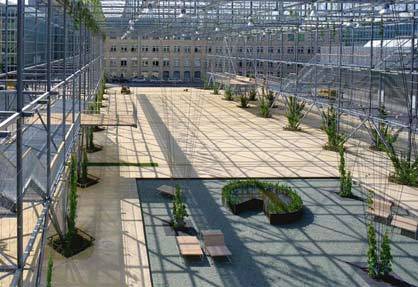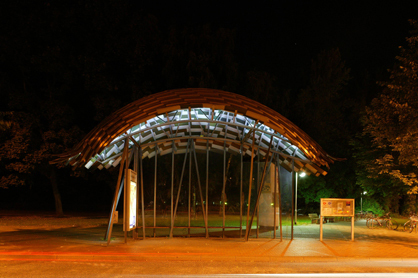Economic crisis – disaster or opportunity?
Texto por Dr. phil. Friederike Mehlau Wiebking
Zürich, Suiza
07.05.09
We have not experienced a crisis of this magnitude since 'Black Friday' in 1929, when the stock market crash rocked the world economy. However, times of recession do not necessarily mean stagnation. In the field of public investment they instead provide an opportunity and a challenge to innovate.
We have not experienced a crisis of this magnitude since 'Black Friday' in 1929, when the stock market crash rocked the world economy. However, times of recession do not necessarily mean stagnation. In the field of public investment they instead provide an opportunity and a challenge to innovate.
With this article Architonic provides input based on examples which look at public spaces as an area for planning and investment.
Public spaces as an area for planning and investment - Science Center/Aquarium/Science theatre OMA in the 'Überseequartier' by Rem Koolhaas from Rotterdam. Copyright: OMA; Source: Hafen City Hamburg GmbH.
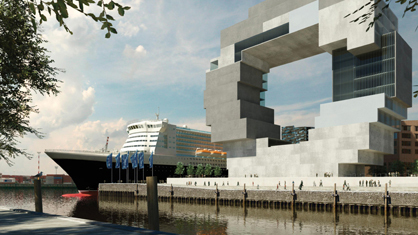
Public spaces as an area for planning and investment - Science Center/Aquarium/Science theatre OMA in the 'Überseequartier' by Rem Koolhaas from Rotterdam. Copyright: OMA; Source: Hafen City Hamburg GmbH.
×The effects of the financial crisis
Without any risk analysis or controls the excesses of the protagonists on the financial markets have now clogged up the circulation of capital, the arteries of the market economy, and have shattered the confidence of the markets' participants in each other's solvency and creditworthiness to an extent which can hardly be imagined.
It is superfluous to point out, but nonetheless true, that private construction work has been affected to a great extent by this downward trend.
Nevertheless recession does not have to mean stagnation in all areas. With public investment in companies, projects and economic stimulus programmes the state – once more operating as a crisis manager in an emergency – offers a wide range of opportunities for contracts and possibilities for the implementation of innovative ideas in the building and planning sectors.
Investment in public transport – bus stop by Allessandro Mendini at Steintor for Hanover/Germany. Copyright Üstra Hanover.
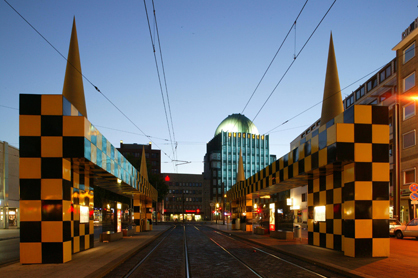
Investment in public transport – bus stop by Allessandro Mendini at Steintor for Hanover/Germany. Copyright Üstra Hanover.
×Crisis as an opportunity for innovation
The public purse contributes financial resources to the areas for which it is responsible in order to revive the economy. Because these resources are generally limited, the competitive situation is extremely tensed and the pressure to provide top quality results is immense. In addition the public authorities are demanded to impose a strict limit on costs, which encourages the development of products that are top quality and at the same time economical, in both material and design terms.
It will be necessary to aim the focus of public investment in the building and planning sector at a range of different levels, in order to ensure the long-term functioning of a highly complex whole. The reason for this is that at times of economic stagnation the highest target should not – for a city or a region for example – be just to maintain the status quo, but to lay the groundwork for future development.
The possible spectrum ranges from planning and its implementation and the execution of public building projects to increasing the property stock of municipalities or state pension funds. A further option is the reorganisation, renewal or development of further urban infrastructure such as energy and water supply, and creating greater security in public areas by improving lighting or bringing new life to public spaces. Art in public buildings, corporate branding or the installation of information and urban guidance systems all make sense within the context of city marketing or promoting local business.
Aerial view of the Hafen City planning and development area in Hamburg/Germany. Copyright: M. Korol; Source: Hafen City Hamburg GmbH
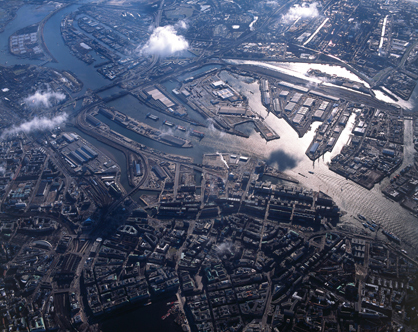
Aerial view of the Hafen City planning and development area in Hamburg/Germany. Copyright: M. Korol; Source: Hafen City Hamburg GmbH
×Investment in public spaces
Investment in urban development:
Hafen City Hamburg – Europe's biggest urban development project
Hafen City is a development project which is taking place in the heart of Hamburg and is huge by European standards. By the year 2020 Hafen City will provide living space for 12'000 people and jobs for 40'000. The new district is being developed by the waterside and will feature a close-grained mixture of uses including residential, business, culture, leisure, shops and restaurants.
The area will be raised to avoid the necessity of building an embankment. This will enable the characteristic views over the water and the essential nature of the area to be maintained, giving the former dock area an atmosphere of appeal and charm. The principle behind the development of the area was to create unmistakable links between high quality architecture and the design of public spaces, involving the interplay between land and water. Lets hope, that besides private investors, the city will be successful reflating the market with this extraordinary project.
Covering an area of 6'400 m2 on three levels, the Marco Polo terraces at the largest public waterside space in Hafen City. Copyright: T.C.Kraus; Source: Hafen City Hamburg GmbH.

Covering an area of 6'400 m2 on three levels, the Marco Polo terraces at the largest public waterside space in Hafen City. Copyright: T.C.Kraus; Source: Hafen City Hamburg GmbH.
×Investment in public buildings:
Temporary travel centre at St. Gallen station
On behalf of the St. Gallen building department architect Peter Lüchinger has designed a temporary travel centre which will be serving as a ticket office for the VBSG local public transport company for 10-15 years.
Free from urban planning constraints the building is strategically placed in relation to the main transport facilities. Its compact cubic design has facades in different colours. A modular system of insulated wooden sections allowed a high level of prefabrication and the building was erected in only three weeks, keeping any disruption to services to a minimum. The multi-functional, prefabricated building designed for temporary use, means a chance for quick financial intervention in public spaces.
VBSG temporary travel centre at St. Gallen station, which has won several awards. Photo source: Architonic Mehlau Wiebking.

VBSG temporary travel centre at St. Gallen station, which has won several awards. Photo source: Architonic Mehlau Wiebking.
×Investment in public green spaces:
MFO Park, North Zurich
On the 0.9 hectare site – a former industrial area previously occupied by the firm of Oerlikon in the north of Zurich and both known and perceived as the 'forbidden city' – a park which can be experienced as a kind of walk-in sculpture was designed in 2001-2002.
The preceding architectural competition was won by the Swiss architects and planners Burckhardt + Partner in cooperation with Raderschall, the landscape architects. The structure is impressive in terms of architecture, landscaping and sculpture and has won many awards.
The park is unusual in character. As if it was making a reference to the former factory building, a framework of steel girders was covered with plants to form a 'green hall'. The steel structure has different levels. The benches give visitors a view of a green, scented framework of girders in which climbing-plant supports, flower baskets and footpaths have been suspended. The many and varied views enable visitors to experience the full dimensions of the 'green factory', a space which can also be used for cultural events. At night the structure is illuminated by artistic lighting.
Projects like the MFO-Park can be initiated within a short period of time, its special charm is starting to show while nature captures the construction.
MFO Park Zurich, seen from the inside. Copyright Burghardt + Partner.
Investment in public transport structures and facilities:
Sculptures in public spaces - Üstra bus stops in Hanover
Exhibitions, especially world expositions, have always provided the inspiration for numerous innovations and have been the cause for a great deal of investment. Not only the host city but the entire surrounding area benefit from such expos, thanks to the many visitors they attract.
For the city of Hanover Expo 2000 initiated an expansion of its local transport network. The so-called 'silver arrow', designed by Herbert Lindinger and Jasper Morrisson/London for Hanover's public transport company, won several design awards.
Bus stop Maschsee/Sprengelmuseum in Hanover. Designed by Heike Mühlhaus. Copyright Üstra Hanover.
However that's not all: as a supplement to the 'silver arrow' the City received a further unmistakable feature in form of a collection of nine unusual bus stops. Each of these bus stops is unique and makes a prominent contribution towards shaping the appearance of the city. In their formal idiom they signalise individuality while at the same time expressing the interplay of function, architecture, design, sculpture and art in public spaces.
As works of art, those bus stops don't have to fulfill the same strict maintenance requirements as for example the modular station system of the Glatttalbahn in the canton of Zurich - so time is slowly taking its toll on them.
The bus stop at Braunschweiger Platz in Hanover by Frank O. Gehry, Copyright Üstra Hanover.





